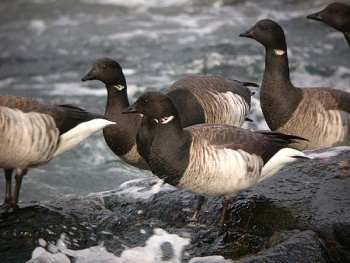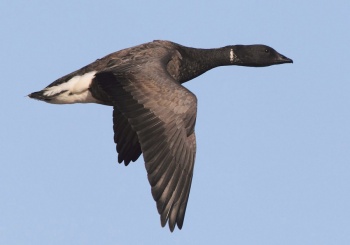Nutcracker (talk | contribs) (more details, rm some duplication) |
|||
| Line 1: | Line 1: | ||
| − | ''' | + | '''Note:''' The spelling '''Brant''' is standard in North America, and the spelling '''Brent''' is standard in Europe. For consistency, 'Brant' is used throughout here, following Clements<sup>[[#References|[1]]]</sup> and IOC<sup>[[#References|[2]]]</sup>. |
| − | [[Image: | + | [[Image:Branta bernicla bernicla by Helios.jpg|thumb|550px|right|''Branta bernicla bernicla''<br />Photo by {{user|Helios|Helios}}<br />[[Cley]], Norfolk, UK; February 2012]] |
;[[:Category:Branta|Branta]] bernicla | ;[[:Category:Branta|Branta]] bernicla | ||
==Identification== | ==Identification== | ||
| − | [[Image:Pale-bellied_Brent_Goose.jpg|thumb|350px|right| | + | [[Image:Pale-bellied_Brent_Goose.jpg|thumb|350px|right|''Branta bernicla hrota''<br />Photo by {{user|Glen+Tepke|Glen Tepke}}<br />Scituate, [[Massachusetts]], [[USA]]]] |
| − | ====Dark-bellied | + | ====Dark-bellied Brant Goose (''B. b. bernicla'')==== |
| − | *Black head and neck | + | *Black head and neck, except for a white '>' mark on each side of the neck. |
| − | *Sharp demarcation from the lower breast, belly, and flank which are | + | *Sharp demarcation from the lower breast, belly, and flank which are dark greyish-brown. |
| − | *Back and wing coverts are darker brown | + | *Back and wing coverts are darker brown. |
| − | *Black wing tips | + | *Black wing tips. |
| − | *The vent, under-tail coverts, and upper-tail coverts (only visible in flight) are white | + | *The vent, under-tail coverts, and upper-tail coverts (only visible in flight) are white. |
| − | *Black tail | + | *Black tail, shorter than in other geese and sometimes concealed by the white under- and upper-tail coverts. |
| − | *Bill, legs and feet are black. | + | *Bill, legs and feet are black. |
| − | ====Pale-bellied | + | ====Pale-bellied Brant Goose (''B. b. hrota'')==== |
| − | Much paler belly almost without contrast between vent/undertail and belly. Otherwise similar to Dark-bellied. | + | Much paler belly and flanks almost without contrast between vent/undertail and belly. Otherwise similar to Dark-bellied. |
| − | ==== | + | ====Grey Brant Goose (''B. b. nigricans'')==== |
| − | [[Image:Black_Brant.jpg|thumb|350px|right| | + | Much as Black Brant, but grey rather than black on rear flanks. |
| + | ====Black Brant Goose (''B. b. orientalis'')==== | ||
| + | [[Image:Black_Brant.jpg|thumb|350px|right|''Branta bernicla orientalis'', one bird (centre) among many ''B. b. bernicla''<br />Photo by {{user|steenl|steenl}}<br />Anjum, Lauwersmeer, [[Netherlands]]]] | ||
Much darker central belly and breast, almost without contrast between upper breast and lower breast, where the other forms are sharply demarcated.<br/> On the other hand, this form has a white flank in contrast both up and down to darker areas, but almost as light as the undertail. The white spot on the side of the neck is often much stronger, and can be continuous at the back of the neck. | Much darker central belly and breast, almost without contrast between upper breast and lower breast, where the other forms are sharply demarcated.<br/> On the other hand, this form has a white flank in contrast both up and down to darker areas, but almost as light as the undertail. The white spot on the side of the neck is often much stronger, and can be continuous at the back of the neck. | ||
====Immature==== | ====Immature==== | ||
*All forms lack the white neck marking | *All forms lack the white neck marking | ||
*White edges to feathers on the wings and back produce a scaly impression | *White edges to feathers on the wings and back produce a scaly impression | ||
| + | |||
==Distribution== | ==Distribution== | ||
| − | + | Circumpolar arctic, wintering on coasts at 30° to 56°N latitude; see taxonomy, below, for detail by subspecies. | |
| − | |||
| − | |||
| − | |||
| − | |||
| − | |||
| − | |||
==Taxonomy== | ==Taxonomy== | ||
| − | + | [[Image:29621.jpg|thumb|350px|right|''Branta bernicla bernicla'' in flight<br>Photo by {{user|targetman|targetman}}<br />[[Lincolnshire]], [[UK]] February 2010]] | |
| − | This species has four subspecies<sup>[[#References|[1]]]</sup> | + | This species has four subspecies<sup>[[#References|[1]]]</sup>; a few people split them as separate species, but this is not widely followed at present. The naming of the subspecies has recently been readjusted, after it was discovered that the [[Dictionary_T-Z#T|type specimen]] of ''B. b. nigricans'' was a Grey Brant Goose, and not a Black Brant Goose as had been previously thought. As a result, the Grey Brant Goose, previously with no scientific name, becomes ''B. b. nigricans'', while the Black Brant Goose is renamed ''B. b. orientalis''<sup>[[#References|[3]]]</sup>. |
| − | + | The four groups are: | |
| − | + | ====Dark-bellied Brant Goose (''B. b. bernicla'')==== | |
| − | + | Breeds in north-central [[Siberia]] (mainly around the Taimyr Peninsula); winters in coastal north-western [[Europe]], mainly in southern [[England]], [[Netherlands]], [[Belgium]], and northern [[France]]. | |
| − | + | ====Pale-bellied Brant Goose (''B. b. hrota'')==== | |
| − | + | Breeds in Franz Josef Land, [[Svalbard]], [[Greenland]] and northeastern [[Canada]]; winters in western [[Denmark]], northeast [[England]], [[Northern Ireland]], and the Atlantic coast of the [[United States]] from [[Maine]] to [[Georgia (U.S. state)|Georgia]]. | |
| − | + | ====Grey Brant Goose (''B. b. nigricans'')==== | |
| − | + | Breeds on Melville Island in central arctic [[Canada]]; winters mainly in the [[Puget Sound]] in [[Washington]] and [[British Columbia]], also small numbers on the [[New Jersey]] coast. | |
| − | + | ====Black Brant Goose (''B. b. orientalis'')==== | |
| − | + | Breeds in northeastern [[Siberia]], northern [[Alaska]], and northwestern [[Canada]]; winters to [[China]], [[Japan]], [[Mexico]], and the west coast of [[North America]]; also a rare vagrant to northwest [[Europe]]. | |
| − | |||
| − | |||
| − | |||
| − | |||
| − | |||
==Habitat== | ==Habitat== | ||
| Line 58: | Line 50: | ||
''[[Media:Branta bernicla (song).mp3|Listen in an external program]]'' | ''[[Media:Branta bernicla (song).mp3|Listen in an external program]]'' | ||
==References== | ==References== | ||
| − | #{{Ref-Clements6thAug11}}#[http://www.birdforum.net/showthread.php?p=2904938 birdforum thread] discussing the forms of | + | #{{Ref-Clements6thAug11}}#{{Ref-GillDonsker14V4.3}}#Reed, A., Ward, D. H., Derksen, D. V., & Sedinger, J. S. (2013). [http://bna.birds.cornell.edu/bna/species/337/articles/systematics Brant ''Branta bernicla'' Systematics] at The Birds of North America Online. |
| + | #[http://www.birdforum.net/showthread.php?p=2904938 birdforum thread] discussing the forms of Brant Goose | ||
#Wikipedia | #Wikipedia | ||
{{ref}} | {{ref}} | ||
Revision as of 22:41, 7 November 2014
Note: The spelling Brant is standard in North America, and the spelling Brent is standard in Europe. For consistency, 'Brant' is used throughout here, following Clements[1] and IOC[2].
- Branta bernicla
Identification
Dark-bellied Brant Goose (B. b. bernicla)
- Black head and neck, except for a white '>' mark on each side of the neck.
- Sharp demarcation from the lower breast, belly, and flank which are dark greyish-brown.
- Back and wing coverts are darker brown.
- Black wing tips.
- The vent, under-tail coverts, and upper-tail coverts (only visible in flight) are white.
- Black tail, shorter than in other geese and sometimes concealed by the white under- and upper-tail coverts.
- Bill, legs and feet are black.
Pale-bellied Brant Goose (B. b. hrota)
Much paler belly and flanks almost without contrast between vent/undertail and belly. Otherwise similar to Dark-bellied.
Grey Brant Goose (B. b. nigricans)
Much as Black Brant, but grey rather than black on rear flanks.
Black Brant Goose (B. b. orientalis)

Photo by steenl
Anjum, Lauwersmeer, Netherlands
Much darker central belly and breast, almost without contrast between upper breast and lower breast, where the other forms are sharply demarcated.
On the other hand, this form has a white flank in contrast both up and down to darker areas, but almost as light as the undertail. The white spot on the side of the neck is often much stronger, and can be continuous at the back of the neck.
Immature
- All forms lack the white neck marking
- White edges to feathers on the wings and back produce a scaly impression
Distribution
Circumpolar arctic, wintering on coasts at 30° to 56°N latitude; see taxonomy, below, for detail by subspecies.
Taxonomy
This species has four subspecies[1]; a few people split them as separate species, but this is not widely followed at present. The naming of the subspecies has recently been readjusted, after it was discovered that the type specimen of B. b. nigricans was a Grey Brant Goose, and not a Black Brant Goose as had been previously thought. As a result, the Grey Brant Goose, previously with no scientific name, becomes B. b. nigricans, while the Black Brant Goose is renamed B. b. orientalis[3]. The four groups are:
Dark-bellied Brant Goose (B. b. bernicla)
Breeds in north-central Siberia (mainly around the Taimyr Peninsula); winters in coastal north-western Europe, mainly in southern England, Netherlands, Belgium, and northern France.
Pale-bellied Brant Goose (B. b. hrota)
Breeds in Franz Josef Land, Svalbard, Greenland and northeastern Canada; winters in western Denmark, northeast England, Northern Ireland, and the Atlantic coast of the United States from Maine to Georgia.
Grey Brant Goose (B. b. nigricans)
Breeds on Melville Island in central arctic Canada; winters mainly in the Puget Sound in Washington and British Columbia, also small numbers on the New Jersey coast.
Black Brant Goose (B. b. orientalis)
Breeds in northeastern Siberia, northern Alaska, and northwestern Canada; winters to China, Japan, Mexico, and the west coast of North America; also a rare vagrant to northwest Europe.
Habitat
Coasts, tidal estuaries, inland agricultural land and low-lying wet coastal tundra for both breeding and feeding.
Behaviour
Breeding
The raised cup-shaped nest is lined with grass and down.
Diet
The diet includes vegetation, especially eel-grass.
Vocalisation
<flashmp3>Branta bernicla (song).mp3</flashmp3>
Listen in an external program
References
- Clements, JF. 2011. The Clements Checklist of Birds of the World. 6th ed., with updates to August 2011. Ithaca: Cornell Univ. Press. ISBN 978-0801445019. Spreadsheet available at http://www.birds.cornell.edu/clementschecklist/downloadable-clements-checklist
- Gill, F and D Donsker (Eds). 2014. IOC World Bird Names (version 4.3). Available at http://www.worldbirdnames.org/.
- Reed, A., Ward, D. H., Derksen, D. V., & Sedinger, J. S. (2013). Brant Branta bernicla Systematics at The Birds of North America Online.
- birdforum thread discussing the forms of Brant Goose
- Wikipedia
Recommended Citation
- BirdForum Opus contributors. (2024) Brant Goose. In: BirdForum, the forum for wild birds and birding. Retrieved 5 May 2024 from https://www.birdforum.net/opus/Brant_Goose
External Links
This link searches for videos titled Brent Goose






